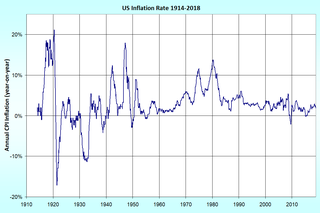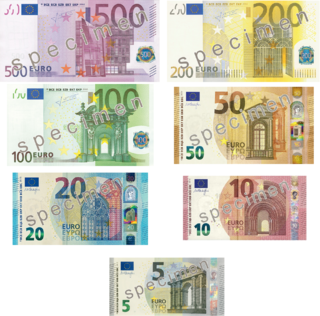
In finance, an exchange rate is the rate at which one currency will be exchanged for another. It is also regarded as the value of one country’s currency in relation to another currency. For example, an interbank exchange rate of 114 Japanese yen to the United States dollar means that ¥114 will be exchanged for each US$1 or that US$1 will be exchanged for each ¥114. In this case it is said that the price of a dollar in relation to yen is ¥114, or equivalently that the price of a yen in relation to dollars is $1/114.
In economics, the GDP deflator is a measure of the level of prices of all new, domestically produced, final goods and services in an economy in a year. GDP stands for gross domestic product, the total monetary value of all final goods and services produced within the territory of a country over a particular period of time.
The Wholesale Price Index (WPI) is the price of a representative basket of wholesale goods. Some countries use WPI changes as a central measure of inflation. But now India has adopted new CPI to measure inflation. However, United States now report a producer price index instead.

Monetary policy is the process by which the monetary authority of a country, typically the central bank or currency board, controls either the cost of very short-term borrowing or the money supply, often targeting an inflation rate or interest rate to ensure price stability and general trust in the currency.
Price stability is a goal of monetary and fiscal policy aiming to support sustainable rates of economic activity. Policy is set to maintain a very low rate of inflation or deflation. For example, the European Central Bank (ECB) describes price stability as a year-on-year increase in the Harmonised Index of Consumer Prices (HICP) for the Euro area of below 2%. However, by referring to “an increase in the HICP of below 2%” the ECB makes clear that not only persistent inflation above 2% but also deflation are inconsistent with the goal of price stability.
In the United Kingdom, the retail prices index or retail price index (RPI) is a measure of inflation published monthly by the Office for National Statistics. It measures the change in the cost of a representative sample of retail goods and services.
Inflation targeting is a monetary policy regime in which a central bank has an explicit target inflation rate for the medium term and announces this inflation target to the public. The assumption is that the best that monetary policy can do to support long-term growth of the economy is to maintain price stability. The central bank uses interest rates, its main short-term monetary instrument.
Core inflation represents the long run trend in the price level. In measuring long run inflation, transitory price changes should be excluded. One way of accomplishing this is by excluding items frequently subject to volatile prices, like food and energy.

The United States Consumer Price Index (CPI) is a set of consumer price indices calculated by the U.S. Bureau of Labor Statistics (BLS). To be precise, the BLS routinely computes many different CPIs that are used for different purposes. Each is a time series measure of the price of consumer goods and services. The BLS publishes the CPI monthly.

The Consumer Price Index (CPI) is the official measure of inflation of consumer prices of the United Kingdom. It is also called the Harmonised Index of Consumer Prices (HICP).
Inflation accounting comprises a range of accounting models designed to correct problems arising from historical cost accounting in the presence of high inflation and hyperinflation. For example, in countries experiencing hyperinflation the International Accounting Standards Board requires corporations to implement financial capital maintenance in units of constant purchasing power in terms of the monthly published Consumer Price Index. This does not result in capital maintenance in units of constant purchasing power since that can only be achieved in terms of a daily index.
The consumer price index (CPI) is the official measure of inflation in South Africa. One variant, the consumer price index excluding mortgage costs (CPIX), is officially targeted by the South African Reserve Bank and a primary measure that determines national interest rates.

Constant purchasing power accounting (CPPA) is an accounting model approved by the International Accounting Standards Board (IASB) as an alternative to traditional historical cost accounting under hyper-inflationary environments. Under this system, financial capital maintenance is measured in units of constant purchasing power (CPP) in terms of a CPI during low inflation. During high inflation and hyperinflation it can also be measured in a monetized daily indexed unit of account and in terms of a daily relatively stable foreign currency parallel rate or daily index.
Inflation rate in India was 3.78% as of August 2015, as per the Indian Ministry of Statistics and Programme Implementation. This represents a modest reduction from the previous annual figure of 9.6% for June 2011. Inflation rates in India are usually quoted as changes in the Wholesale Price Index (WPI), for all commodities

The National Bank of Liechtenstein is a bank located in Liechtenstein, based in the capital city Vaduz. Since 1993 it has been listed as a company at the Swiss Stock Exchange, with the majority of shares (57.5%) owned by the Liechtenstein state. As the state is in a customs and monetary union with Switzerland and have adopted the Swiss franc as official currency, the monetary policy and money supply is the sole responsibility of the Swiss National Bank.








